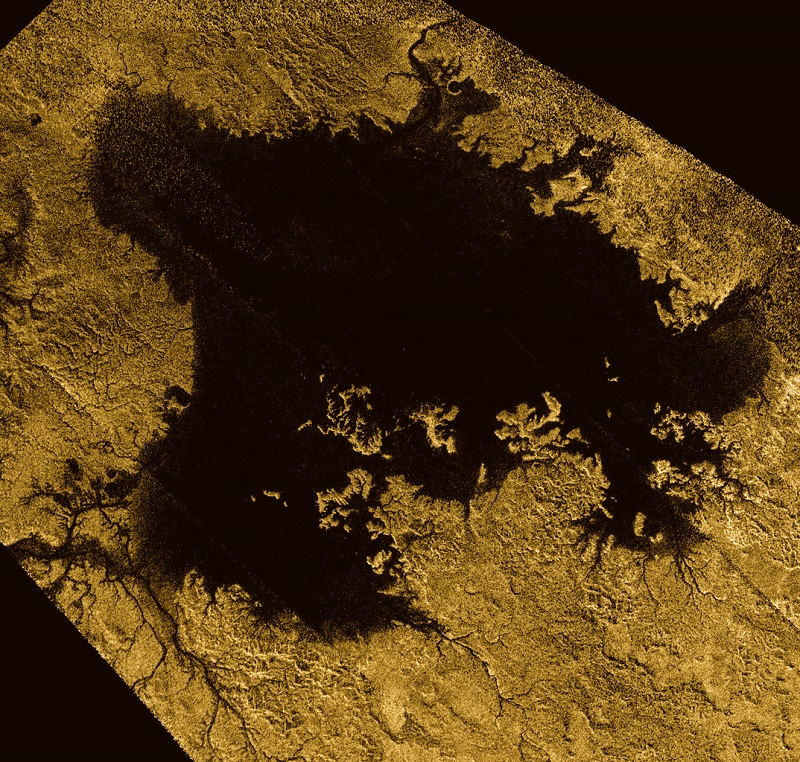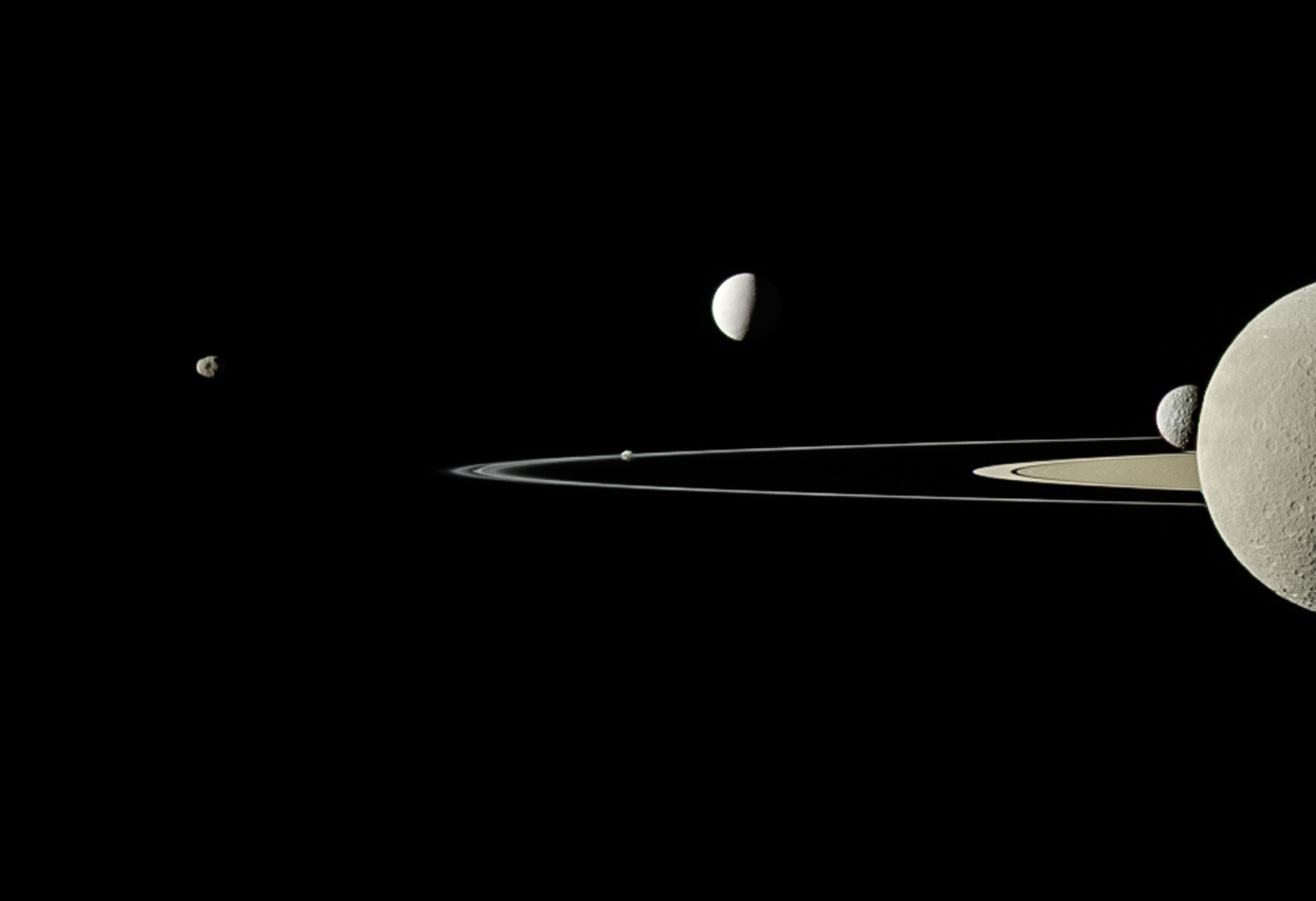Skip to comments.
NASA may decide this year to land a drone on Saturn's moon Titan
Space.com ^
| January 16, 2019
| Meghan Bartels, Space.com Senior Writer
Posted on 01/17/2019 8:13:56 AM PST by ETL
The spacecraft that have peered through the yellowish haze surrounding Saturn's moon Titan discovered a strange, yet strangely familiar world where life could theoretically take root. Now, scientists want to return — this time buoyed by Earth's fascination with drone technology.
That's precisely what a team of scientists working on a proposed mission called Dragonfly want to do: combine terrestrial drone technology and instruments honed by Mars exploration to investigate the complex chemical reactions taking place on Saturn's largest moon. Later this year, NASA will need to decide between that mission and another finalist proposal, which would collect a sample from a comet.
"At first blush, I think a lot of people think [Dragonfly] sounds like the literal meaning of incredible," Melissa Trainer, a deputy principal investigator with the mission and a scientist at NASA, told Space.com. "Not only is this an incredibly exciting concept with amazing, compelling science, but also, it is doable — it's feasible from an engineering standpoint."
[Landing on Titan: Pictures from Huygens Probe on Saturn Moon]
Dragonfly, if chosen, would aim to launch in 2025 and arrive at Titan in 2034. The world it will explore is oddly reminiscent of Earth for a strange moon so far away. On Earth, sunlight powers organic life growing in fields and forests; the same sunlight triggers chemical reactions in Titan's upper atmosphere that create large organic molecules that pour down on the moon's surface, like Earth's rainwater. While Earth has a landscape made of rock covered in places by water, Titan's landscape is made of water ice covered in places by organic compounds.
Knowledge of those Titan traits comes primarily from data gathered by the Cassini mission to the Saturn system and the Huygens probe that traveled with Cassini and touched down on Titan in 2005. Taken together, those two spacecraft completely reshaped scientists' ideas about the moon.
"We didn't know how Titan worked as a system before Cassini got there. We had tantalizing hints, but Cassini and Huygens really took it from [being] this mysterious moon to [being] a place that is incredibly familiar," Elizabeth "Zibi" Turtle, principal investigator for Dragonfly and a planetary scientist at the Johns Hopkins University Applied Physics Laboratory, told Space.com. "Cassini really showed us Titan as a world and how it works and the different processes that are acting on it."
But Cassini never got a good view of the surface through the moon's thick atmosphere, and once the Huygens probe touched down, it ran out of battery power in mere hours. If all goes smoothly, Dragonfly would be able to explore dozens of sites over the course of two Earth years. And some aspects of the proposed mission aren't as difficult as you might expect.
Consider landing, for example. Trainer, who also works with the Curiosity rover on Mars, remembers well the so-called "7 minutes of terror" during that rover's action-packed landing, as the spacecraft fought to slow itself quickly enough to touch down gently. "Compared to that, landing on Titan is just this leisurely, gentle float down to the surface," she said. "It takes something like over 2 hours because of this dense atmosphere."
That atmosphere, which Trainer compared to a pillow, combined with the low gravity on the moon (about a seventh the strength of Earth's) also makes putting an aircraft on a distant moon much more feasible. With its rotor-copter design, Dragonfly can lift itself off the surface and fly away using the nuclear power source that NASA had available for this class of mission.
But incorporating extraterrestrial drone technology is a means to an end, not the final goal. "We focus so much on the flight, and that's what we show in the pictures, because that's part of the really exciting part. But the truth is we really spend most of the time on the surface," Trainer said. "We're really a landed package, a science laboratory — we're doing [most of] our science on the ground, and then we fly to relocate and to get some data on the surface. We move to a new place and then we do more landed science."
[Amazing Photos: Titan, Saturn's Largest Moon]
That science will tackle the chemistry on Titan. Scientists know that the moon hosts huge amounts of organic compounds, but Cassini and Huygens didn't gather enough data to clarify the details of the planet's chemistry. Dragonfly would be able to identify precise organic compounds, so scientists could determine just how close Titan's molecules are to those that terrestrial biology relies on.
"Dragonfly is first and foremost a mission to understand prebiotic chemistry. What happened to get from chemistry to biology?" Turtle said. "Of course, we can't study that on Earth, because biology has kind of overprinted everything, but Titan is actually the place that is most like the early Earth in the solar system."
Scientists have run experiments to try to mimic Titan in the laboratory, testing what compounds the ingredients and conditions they replicate produce. Those experiments have had intriguing results — the reactions can create amino acids, for example, the building blocks of proteins — but they can never run indefinitely. "In the laboratory, you're always limited by time. Titan has been doing this for millions and millions of years," Trainer said. "Titan has basically been doing these experiments for us, and all we're trying to do is go and get the results."
And if the mission's impetus comes from the Cassini and Huygens missions, the methodology to fetch those results is inspired by a very different suite of spacecraft: NASA's Mars rovers. After all, Titan isn't the first place NASA has studied organic compounds; that's precisely what the Curiosity rover was designed to do. So, Dragonfly would carry some of the same instruments adapted for a new context.
Whether Dragonfly takes flight is now up to NASA. The Dragonfly team submitted a detailed concept report in December and is expecting a decision from the agency this summer. The team members said they think they've made a compelling case for both the science that the mission could do and its feasibility.
"It's amazing, but it's not crazy," Trainer said.
TOPICS: Astronomy; Chit/Chat; Science
KEYWORDS: saturn; titan

An artist's depiction shows each stage of the proposed Dragonfly mission, including landing on Titan's surface,
doing science in place and relocating to a new work site

Data from the Cassini mission to Saturn show a large lake on Titan's surface. Liquid on the moon's surface is
predominantly organic compounds like methane (shown in black here); the solid surface is made of water ice (shown in gold here)
Credit: NASA/JPL-Caltech/ASI/Cornell
1
posted on
01/17/2019 8:13:56 AM PST
by
ETL
2
posted on
01/17/2019 8:14:41 AM PST
by
ETL
(Obama-Hillary, REAL Russia collusion! Uranium-One Deal, Missile Defense, Iran Deal, Nukes: Click ETL)
To: All

On July 29, 2011, Cassini captured five of Saturn's moons in a single frame with its narrow-angle camera. This is a full-color look at a view that was originally published in September 2011 (see PIA14573).
Moons visible in this view: Janus (111 miles, or 179 kilometers across) is on the far left; Pandora (50 miles, or 81 kilometers across) orbits just beyond the thin F ring near the center of the image; brightly reflective Enceladus (313 miles, or 504 kilometers across) appears above center; Saturn's second largest moon, Rhea (949 miles, or 1,528 kilometers across), is bisected by the right edge of the image; and the smaller moon Mimas (246 miles, or 396 kilometers across) is seen just to the left of Rhea.
This view looks toward the northern, sunlit side of the rings from just above the ringplane. Rhea is closest to Cassini here. The rings are beyond Rhea and Mimas. Enceladus is beyond the rings. The view was acquired at a distance of approximately 684,000 miles (1.1 million kilometers) from Rhea and 1.1 million miles (1.8 million kilometers) from Enceladus.
The Cassini spacecraft ended its mission on Sept. 15, 2017. ..."
https://www.jpl.nasa.gov/spaceimages/details.php?id=PIA12797
3
posted on
01/17/2019 8:18:06 AM PST
by
ETL
(Obama-Hillary, REAL Russia collusion! Uranium-One Deal, Missile Defense, Iran Deal, Nukes: Click ETL)
To: ETL

https://en.wikipedia.org/wiki/Code_of_the_Lifemaker
4
posted on
01/17/2019 8:19:02 AM PST
by
Red Badger
(We are headed for a Civil War. It won't be nice like the last one....................)
To: All
5
posted on
01/17/2019 8:23:19 AM PST
by
ETL
(Obama-Hillary, REAL Russia collusion! Uranium-One Deal, Missile Defense, Iran Deal, Nukes: Click ETL)
To: ETL
6
posted on
01/17/2019 8:29:31 AM PST
by
DCBryan1
(Quit calling them liberals, progs, socialists, or democrats. Call them what they are: COMMUNISTS!!!!)
To: ETL
This is not news it is speculation. For one thing, may decide is pretty non-specific. For another, it is a huge f-ing distance to send a space probe at not a trivial cost. Write me an article when NASA actually has the funds and is a launch date, then I will get interested. Right now a senior blogger is clickbaiting with words like NASA, drone and Saturn’s moon Titan.
7
posted on
01/17/2019 8:34:39 AM PST
by
webheart
(Grammar police on the scene.)
To: ETL
Dragonfly, if chosen, would aim to launch in 2025 and arrive at Titan in 2034.
...
NASA (the government) is way too slow.
8
posted on
01/17/2019 8:49:47 AM PST
by
Moonman62
(Give a man a fish and he'll be a Democrat. Teach a man to fish and he'll be a responsible citizen.)
Disclaimer:
Opinions posted on Free Republic are those of the individual
posters and do not necessarily represent the opinion of Free Republic or its
management. All materials posted herein are protected by copyright law and the
exemption for fair use of copyrighted works.
FreeRepublic.com is powered by software copyright 2000-2008 John Robinson





